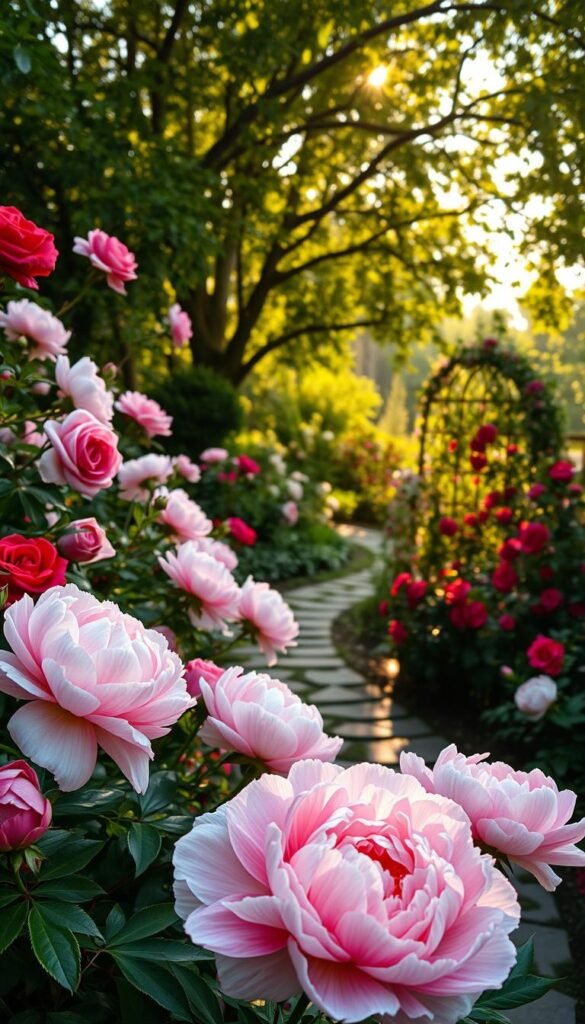Imagine stepping into a space where soft petals dance with vibrant hues, creating an atmosphere that feels straight from a storybook. Pairing complementary blooms unlocks endless possibilities for crafting outdoor magic. This guide reveals how to blend two iconic plants into arrangements that bloom harmoniously season after season.
You’ll explore the art of matching textures and growth habits to create visual balance. Proper spacing and sunlight management ensure both varieties thrive without competing. Discover how staggered planting extends your display’s lifespan, with early summer blossoms making way for later performers.
Color coordination matters more than you might think. Soft pinks paired with creamy whites establish serenity, while bold crimson accents add drama. We’ll show you how to sequence plantings so fading blooms naturally transition to emerging ones, maintaining continuous charm.
These proven combinations work in various climates and soil types. Whether you’re enhancing borders or designing focal points, you’ll learn techniques professionals use to create depth and dimension. Your outdoor area will become a living canvas that evolves beautifully from spring through fall.
Introduction to Creating a Romantic Garden Atmosphere
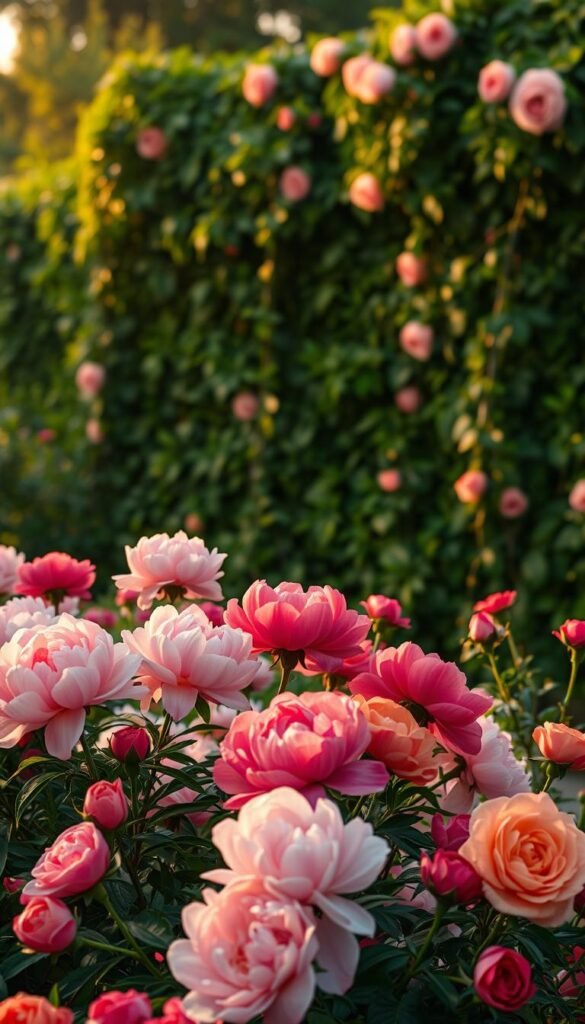
Transform your outdoor space into a serene retreat where every element whispers charm. The secret lies in choosing blooms that stir emotions, from nostalgic affection to peaceful contemplation. Soft blush tones and ivory shades work like visual poetry, establishing an ambiance of refined grace.
Setting the Mood with Lush Blooms and Soft Hues
Color psychology transforms mere plantings into emotional experiences. Pale apricot and dusty mauve varieties create calming focal points, while creamy whites add luminous contrast. Subtle shifts between similar tones guide the eye gently, avoiding harsh visual breaks.
Layering different plant heights builds depth without clutter. Taller specimens form natural backdrops, while cascading varieties soften edges. This approach ensures your space feels intimate yet spacious—perfect for quiet moments or shared conversations.
Fragrance elevates the experience dramatically. Sweet-smelling varieties near seating areas engage multiple senses, while evening lighting extends the magic into twilight hours. Solar-powered path markers or discreet string lights maintain the delicate atmosphere after sunset.
Understanding the Art of Floral Pairing
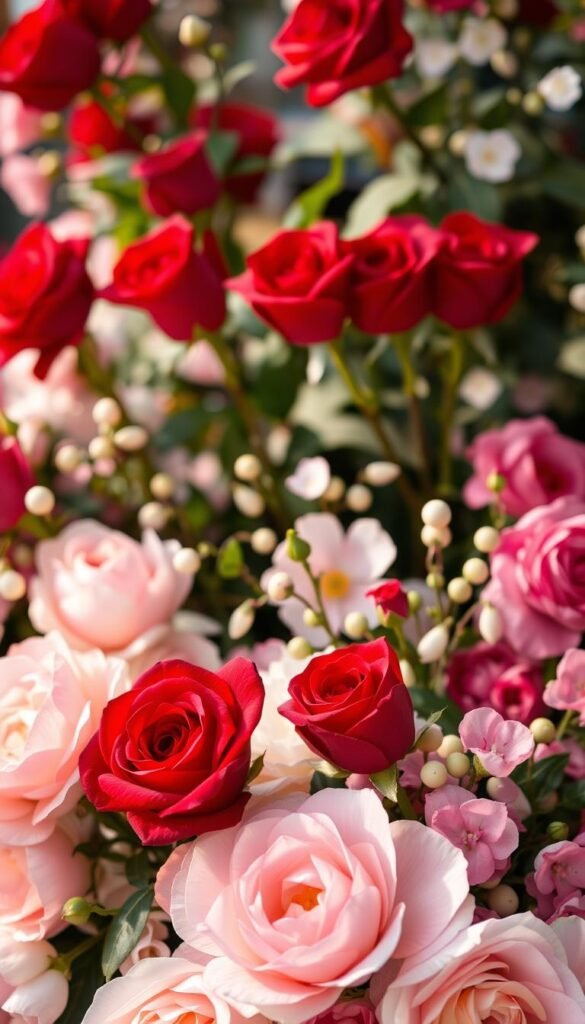
What if your garden could tell a richer story through thoughtful partnerships between blooms? Strategic pairings transform solitary beauties into dynamic ensembles. This approach goes beyond aesthetics—it’s about fostering relationships where companion plants support each other’s growth while creating visual poetry.
Defining Companion Planting in Your Garden
Companion planting pairs species that thrive together. For roses, this means selecting neighbors with complementary needs. Look for flowers that share similar sunlight requirements but differ in root depth. This prevents competition while maximizing space.
| Companion Plant | Benefit | Bloom Period |
|---|---|---|
| Lavender | Repels aphids | Early summer |
| Catmint | Attracts pollinators | Spring to fall |
| Salvia | Deters beetles | Summer |
Key Benefits of Strategic Flower Combinations
Smart pairings extend your garden’s performance. Early-blooming companion flowers fill gaps before rosebuds open. Later varieties conceal fading petals. This layered approach ensures continuous color.
Healthier plants emerge when partners deter pests naturally. Marigolds release soil-enhancing compounds, while yarrow improves nutrient uptake. You’ll reduce chemical use while boosting resilience.
Texture contrasts add depth—feathery cosmos soften rigid rose stems. Vining clematis adds vertical interest. These combinations create living tapestries that evolve daily.
Peony and Rose Flower Garden Combos: Classic Pairings for a Romantic Look
There’s a reason certain plant pairings never go out of style. When you blend the lush, billowy shapes of peonies with the structured elegance of roses, you create living artistry that evolves with the seasons. Their staggered bloom times mean your space transitions seamlessly from spring’s exuberance to summer’s warmth.
Timing is everything in this partnership. Early-blooming varieties like ‘Sarah Bernhardt’ peonies dazzle in May, while hybrid tea roses take center stage by June. This natural handoff ensures your beds never look bare. Want continuous color? Try planting late-season peony cultivars alongside repeat-blooming roses.
The magic lies in texture play. Ruffled peony petals soften rose stems, creating contrast that feels both cozy and refined. For striking visual harmony:
- Pair coral-hued ‘Coral Charm’ peonies with apricot-toned ‘Juliet’ roses
- Combine white ‘Duchesse de Nemours’ peonies with blush pink ‘Queen of Sweden’ roses
- Use deep red ‘Karl Rosenfield’ peonies as bold accents against pale ‘Iceberg’ roses
Both plants thrive in similar conditions—well-drained soil and 6+ hours of sunlight. Give them room to breathe: space peonies 3-4 feet apart and roses 2-3 feet. A layer of mulch keeps roots happy while suppressing weeds. With smart placement, you’ll create a living tapestry that grows more captivating each year.
Creating Color Harmony in Your Arrangements
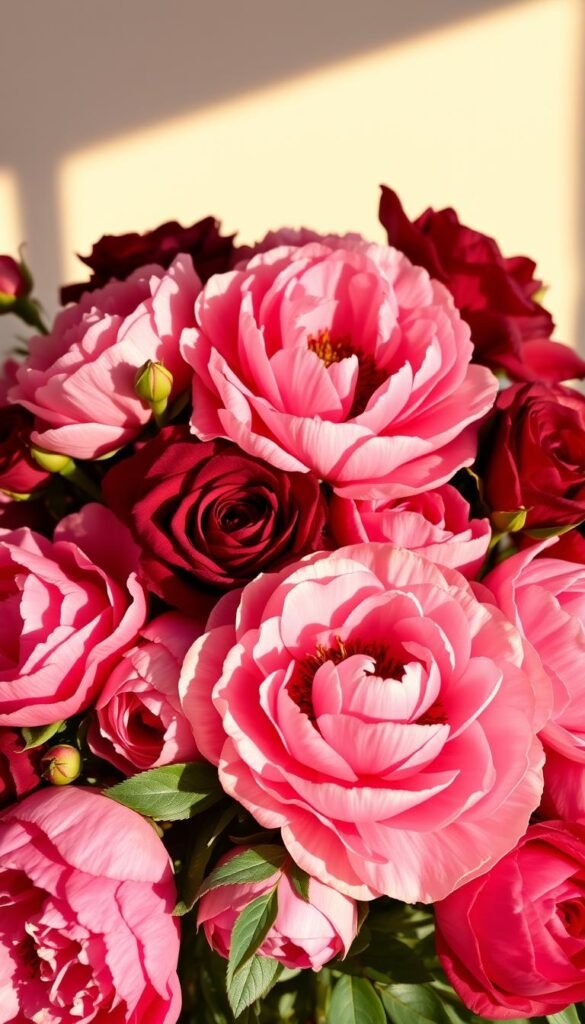
Color transforms your garden into a living painting where every hue tells part of the story. Like mixing paints on a palette, selecting the right shades creates visual rhythm that feels both intentional and effortless.
Choosing Complementary Shades
Opposite colors on the wheel create instant drama. Try yellow roses beside violet lavender—the contrast makes both pop. Soft pinks paired with crisp whites offer a calmer effect, perfect for serene spaces.
Lighting changes everything. Morning sun intensifies warm tones, while dusk softens bold colors. Test combinations at different times to see how shadows and brightness alter their impact.
Balancing Bold and Pastel Blooms
Vibrant reds need neutral partners to avoid overwhelming. Pair crimson blooms with silvery lamb’s ear or airy baby’s breath. This lets intense colors shine without creating visual noise.
Pastels gain depth when layered. Dusty mauve roses look richer beside lavender spires, while peach tones glow against sage-green foliage. These subtle shifts guide the eye gently through your design.
Remember:
- Blue salvia cools down bright pink roses
- Purple verbena adds energy to sunny yellow varieties
- White alyssum creates clean lines between color blocks
Seasonal Blooms: Enhancing Your Garden Year-Round
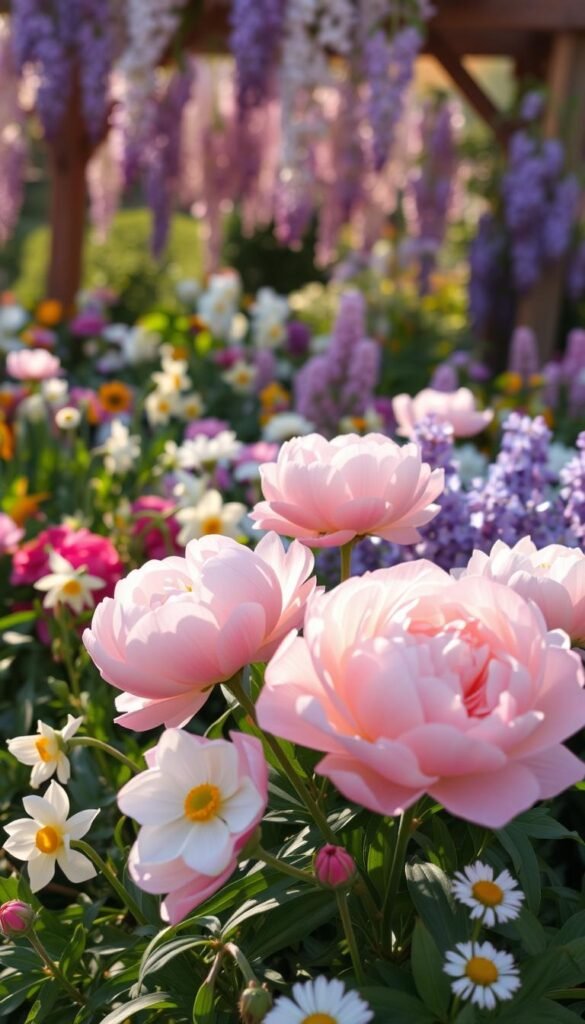
Your outdoor space can become a living calendar of color with thoughtful plant selection. By aligning bloom cycles, you craft displays that shift gracefully from spring’s freshness to autumn’s warmth.
Spring and Summer Flower Pairings
Early risers like tulips burst forth as rose stems awaken. Their cheerful yellows and reds create vibrant borders before summer’s stars take over. When temperatures climb, lavender’s purple spikes complement rosebuds perfectly—both thrive in sunny spots.
Zinnias offer bold summer hues that withstand heat waves. Plant them near repeat-blooming varieties for continuous fireworks of color. Succession planting ensures no bare patches—as daffodils fade, salvia emerges to fill the gap.
Fall Transitions and Late Blooms
As days shorten, chrysanthemums become showstoppers. Their burnt oranges and deep burgundies mirror autumn leaves while extending visual interest. Pair them with asters for texture contrast—their daisy-like shapes soften mum’s dense petals.
Late-season arrangements benefit from strategic timing. Plant summer bloomers slightly later to overlap with fall varieties. This overlap creates seamless transitions, making your space feel perpetually alive.
Expert Tips for Perfectly Layered Rose and Peony Displays
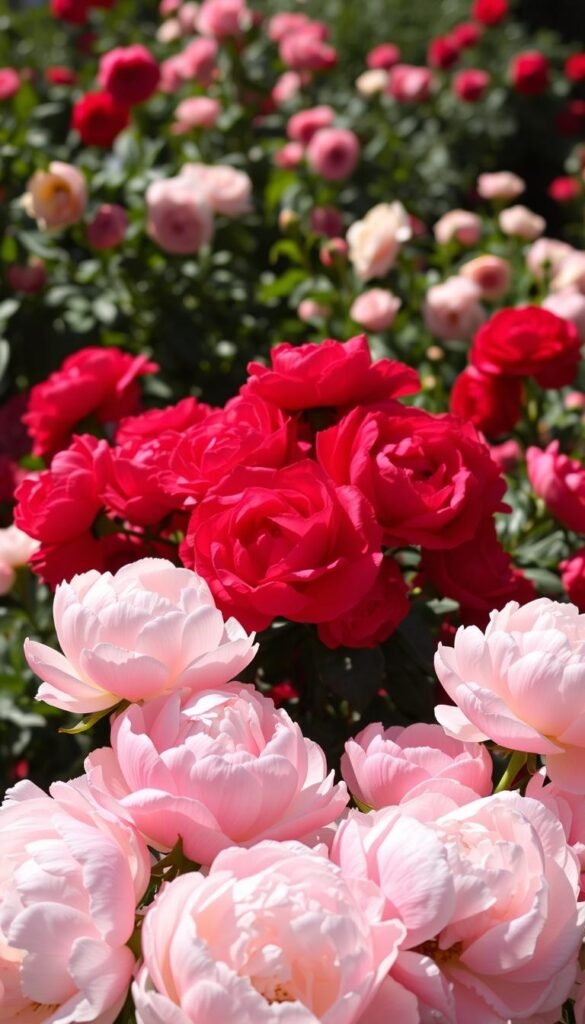
Mastering layered displays transforms simple plantings into living sculptures. Start by balancing shape and size—the rounded forms of roses need contrasting partners. Tall snapdragons add vertical drama, while baby’s breath introduces airy lightness to prevent visual weight.
Fragrance layering creates immersive experiences. Pair fragrant varieties with aromatic herbs like rosemary or lavender near seating areas. This dual-sensory approach makes your space memorable—scented petals by day, herbal whispers by evening.
Texture mixing elevates your aesthetic instantly. Combine velvety rose petals with spiky sea holly or feathery astilbe foliage. These contrasts add tactile interest that catches sunlight differently throughout the day.
- Space plants using the “elbow room” rule: allow 1.5x their mature width between specimens
- Use tiered planting—tallest varieties at the back, cascading types along edges
- Repeat color blocks in diagonal patterns to guide the eye naturally
For dynamic arrangements, consider vertical elements. Vining plants like sweet peas add height without crowding. Discover how colorful container displays can enhance layered beds with portable accents.
Incorporating Companion Plants for Rich Texture
Textures transform gardens into tactile experiences where every leaf and petal contributes to the overall design. Strategic additions create depth while enhancing your main blooms’ visual impact. Let’s explore how specific companions elevate your arrangements through contrast and harmony.
Integrating Delicate Daisies, Lavender, and Other Plants
Lavender steals the spotlight with its spiky purple blooms and calming fragrance. Plant it near pink or white roses—the vertical lines break up rounded shapes beautifully. Its silver-green foliage adds subtle contrast even when not flowering.
Daisies bring playful simplicity to formal arrangements. Their white or yellow centers brighten red roses in casual borders. For best results, cluster them in groups of three to five plants near pathway edges.
| Companion | Texture | Best Paired With |
|---|---|---|
| Lavender | Spiky | Pink roses |
| Shasta Daisy | Flat petals | Red roses |
| Catmint | Feathery | White peonies |
Using Hydrangeas and Clematis for Depth
Hydrangeas act as living pillows beneath taller blooms. Their mophead varieties in blue or pink balance rose stems’ structure. Place them where afternoon shade protects their moisture-loving roots.
Clematis vines climb trellises behind flower beds, adding vertical drama. Choose varieties like ‘Nelly Moser’ with striped petals that echo your roses’ hues. Prune annually to maintain manageable growth.
Remember to:
- Space hydrangeas 4 feet apart for air circulation
- Mulch clematis roots to keep them cool
- Combine different bloom sizes for layered interest
Designing Garden Beds with Classic and Contemporary Combos
What makes a garden bed feel both timeless and fresh? The answer lies in blending traditional layouts with modern twists. Start by anchoring your design with heritage favorites, then introduce unexpected elements like geometric patterns or monochromatic accents. This fusion creates spaces that honor tradition while feeling distinctly yours.
Traditional borders thrive when paired with clean lines. Try repeating clusters of heritage favorites in symmetrical patterns, then offset them with bold foliage or ornamental grasses. This contrast adds rhythm without overwhelming the eye. For small spaces, vertical planters let you layer textures upward—perfect for urban settings.
Three design elements elevate modern-retro beds:
- Monochromatic sections using varied leaf shapes
- Strategic repetition of key plants
- Unexpected materials like corten steel edging
Focal points guide the viewer’s gaze naturally. Position showstopping combinations where paths curve or seating areas begin. A circular bed with central specimen plants works wonders in open lawns. For inspiration on layout possibilities, explore peony and rose garden layouts that balance structure with whimsy.
Maintenance matters as much as aesthetics. Group plants with similar water needs, and leave room for air circulation. Mulch with gravel in contemporary zones, organic bark in traditional sections. This practical approach keeps your creation thriving while preserving its artistic vision.
Exploring Unique Pairings Beyond Tradition
Break free from predictable arrangements and discover combinations that spark joy while honoring your garden’s romantic roots. Unconventional partners can elevate classic favorites by introducing fresh textures and subtle surprises. Let’s reimagine what’s possible when tradition meets innovation.
Mixing Exotic Blooms with Timeless Classics
Dare to pair delicate roses with bold tropical stunners. Bird-of-paradise flowers add architectural drama when placed behind softer blooms, while orchids introduce sleek modernity. The key? Choose exotic varieties with similar sunlight needs but contrasting forms.
For a softer approach, try Japanese anemones. Their late-summer blossoms bridge the gap between fading peonies and autumn-blooming flowers. Their wispy stems create movement, making rigid rose bushes feel more dynamic.
Unexpected Plants That Elevate Beauty
Silver-leafed artemisia adds moonlight-like glow to crimson roses after dusk. Its fuzzy foliage contrasts beautifully with glossy petals while repelling pests naturally. Even better? It thrives in the same well-drained soil as your low-maintenance options.
Consider these rule-breaking partners:
- Feathery fennel for airy texture contrasts
- Black mondo grass for dramatic ground cover
- Variegated hostas to brighten shady corners
These plants prove that unconventional choices can enhance—not overpower—your garden’s beauty. They create moments of discovery while keeping the overall aesthetic cohesive. The result? A space that feels both familiar and thrillingly new.
DIY Guide to Arranging Stunning
Crafting breathtaking floral displays starts with knowing your materials. Gather stems at their peak—early morning cuts last longest. Use sharp shears for clean slices, and immediately place them in lukewarm water with flower food.
Build your arrangement around a focal bloom. Angle taller stems toward the center for natural-looking depth. Rotate your vase as you work to ensure balanced visibility from all sides. Add filler greens sparingly—they should complement, not overwhelm.
Color progression creates flow. Start with lighter hues at the edges, deepening toward the center. Crisscross stems to form supportive grids that keep delicate blooms upright. Change water daily to extend vase life dramatically.
For lasting impact, mix varied textures. Combine velvety petals with spiky accents or feathery foliage. Let your creation breathe—overcrowding shortens display longevity. With these techniques, you’ll craft arrangements that captivate from first bud to final bloom.

